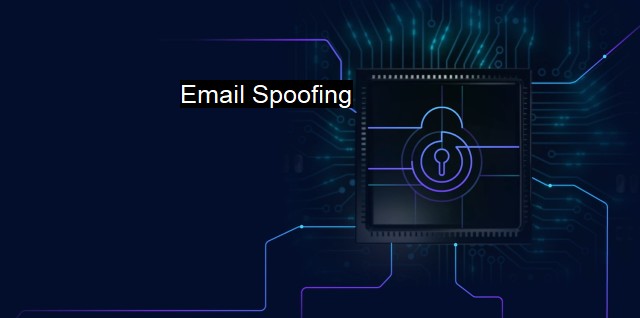What is Email Spoofing?
Uncovering Email Spoofing: Strategies and Tools to Prevent Cyber Attacks via Manipulated Sender Identities
Email spoofing is a potent and underhanded cybersecurity threat, essentially a cyber attack tool used to trick people into attributing thought or action to an individual misrepresented in a fraudulent communique. In a more significant context, it often forms the backbone of an intricate auto-defensive system, signaling the predecessors of potentially larger threats.To understand email spoofing, it is essential first to comprehend what exactly happens during the exchange of an email. Basically, an email consists of three parts: the envelope, the header, and the body. The envelope carries routing information and is staggeringly straightforward to fake. The Header holds details like the sender, recipient, the subject, and the time it was sent. At any rate, non-essential information may be spoofed. Lastly, the body contains the actual content that the recipient sees. Understanding this divide is critical in unraveling the control phishing attackers might have over emails.
When the envelope is spoofed, it tricks the server into thinking the email originated from a legitimate server, thereby bypassing any potential blocks or flags. With the header, users see misleading sender information that becomes the base for email spoofing. Consequently, attackers can make an email appear as if it’s from the recipient’s trusted contacts.
Attackers use email spoofing for various reasons. In part, it is the destabilizing foundation for phishing, sparking major cybersecurity concerns. It allows cybercriminals to send emails purporting to be from trusted sources. They capitalize on the recipient's trusting nature to open the emails or click on the links transferred, triggering an attack. Looking at phishing, particularly from a cybersecurity perspective, it's even more sinister. It directly targets the user's interaction and trust parameters. Step-by-step, it weaves a treacherous web (often referred to as 'Tangled Web Attacks'), broadcasting a series of actions leading to a severe security breach or compromising sensitive data.
Distributed Denial-of-Service (DDoS) attacks are another example of scenarios where email spoofing can be used. Here, the attacker floods an email server's inbox with thousands, if not millions, of spoofed emails, disabling or even crippling the server.
As a part of the cybersecurity measures, antivirus software vendors propose solutions that can manage or even prevent email spoofing attacks. Antivirus solutions scan incoming emails on servers and end-user devices, analyzing them for potential threats. Sometimes this involves running email addresses through threat intelligence databases to determine email reputation.
Similarly, measures such as Domain-Based Messaging Authentication, Reporting, and Conformance (DMARC), Sender Policy Framework (SPF), and DomainKeys Identified Mail (DKIM) have come into existence addressing this issue. These authentication methodologies involve a server-side check up to guard the email environment against potential spoofs. These measures work together, adding substantial barriers to intruders planning to wage attacks via spoofed emails.
Notwithstanding these methodologies and cybersecurity frameworks, email spoofing remains a significant threat, morphing continuously as attackers perfect their craft to escape discovery and remain undeterred. This calls for complex, multi-tiered security frameworks and routine up-gradation of cybersecurity methods to stay current with evolving threats--a practice underscored by today's hard-pressing cybersecurity discussions around the globe. Proactive cybersecurity measures are functional deterrents to stride safely alongside the threat, ensuring the safety of data and preserving trust in online interactions.
The discussion around email spoofing and forthcoming cybersecurity gestures continue unraveling complex scenarios that need adaptive solutions. As technology continues to evolve, so does the threat landscape. It sets a distinguished emphasis on the necessity for all organizations to develop, implement, and consistently review dynamic cybersecurity measures to cope with sophisticated threats like email spoofing.

Email Spoofing FAQs
What is email spoofing?
Email spoofing is a technique used by cybercriminals to send emails with a forged sender address to trick the recipient into thinking the email is from a legitimate source.Why is email spoofing dangerous?
Email spoofing can be used to deliver malware or phishing attacks, steal sensitive information or gain unauthorized access to a computer or network. It can also damage the reputation of legitimate organizations whose domain names are used in the spoofed emails.How can I protect myself and my organization from email spoofing?
One way to protect against email spoofing is to use SPF (Sender Policy Framework), DKIM (DomainKeys Identified Mail) and DMARC (Domain-based Message Authentication, Reporting and Conformance) protocols that authenticate the sender's identity and prevent spoofing. It's also important to educate employees on how to recognize and report suspicious emails.What should I do if I receive a suspicious email?
If you receive a suspicious email, do not open any attachments or click on any links. Report it to your IT department or security team immediately. They can investigate and take necessary actions to protect your organization.| | A | | | B | | | C | | | D | | | E | | | F | | | G | | | H | | | I | | | J | | | K | | | L | | | M | |
| | N | | | O | | | P | | | Q | | | R | | | S | | | T | | | U | | | V | | | W | | | X | | | Y | | | Z | |
| | 1 | | | 2 | | | 3 | | | 4 | | | 7 | | | 8 | | |||||||